
Wine Culture and Information since 2002 - Volume 22
 Wine Culture and Information since 2002 - Volume 22 |
|
Issue 238, April 2024 |
Contents |
|
|
Australia Between the Red Wine Crisis and the Destruction of Vineyards |
|
Wine is facing hard times, in particular, red wine. A decidedly difficult period in a general sense – for some time, in fact, consumer consensus has decreased – particularly for Australian consumers. Land of great wines, Australia is famous throughout the world above all for its reds, although other styles of wines are also produced in the great land of kangaroos. It is the reds, however, that mainly dominate consumer preferences, both in the domestic and export markets. In the land of kangaroos – in fact – most of the vineyards are mainly cultivated with the red Syrah, Cabernet Sauvignon and Merlot varieties which, together, represent the most important share of wine production. Among the whites, Chardonnay is the variety attracting the main interest of winemakers. The undisputed glory of Australia is Syrah, here and elsewhere known as Shiraz and it is with this name we find it on Australian bottle labels. In the world of wine, and not only in Australia, there has been a worrying phenomenon for some time representing a serious obstacle for producers, who are called upon to deal with a problem that, apparently, has never occurred in such an important extent. In fact, it is known that many wineries are called to manage an excess of unsold wine which, in addition to taking up precious logistical space, also weighs on company budgets. The situation becomes even more critical with the arrival of the new harvest, a condition which forces the grapes to be harvested in order to make the new wine, which requires space for storage, thus increasing costs which inevitably further burden the missed profit from the previous year. According to what was released by the International Organization of Vine and Wine (OIV), in 2023 overall production exceeded real market demand by +10%. Unsold wine, therefore, which remains stored in the producers' cellars. This condition has led to an overall drop in prices, thus putting producers' profits and, therefore, their very “survival”, at risk. Apparently, this condition has become extremely serious in Australia, where producers have been suffering for some years the consequences of the Chinese government's decision to impose very high duties on Australian wine. As is known – in fact – this is a decision introduced by the Chinese government last March 2020 as a consequence of a “diplomatic crisis” with Australia due to events related to the Covid-19 pandemic. This measure, inevitably, caused Australian wine to literally disappear from the Chinese market. According to economic estimates, the value of Australian wine exports to China – which represents the main market for Australia – has suffered a drastic collapse, going from 662 million dollars to just 6.6 million in the last year. Australia has therefore been forced to face a huge excess of unsold wine, putting the entire sector in crisis. Australian producers have sought new markets in Europe and America, however, the current downward trend in consumption in these areas of the world has not allowed them to address, at least in part, this crisis. To this it must also be added that in Australia – just like elsewhere – domestic wine consumption has decreased. According to estimates released by the government, as of last July 2023, more than two billion liters of wine were stored in Australian cellars, equivalent to approximately two years of production. A huge quantity that forced Australian producers to sell off excess wine to discount supermarket chains. Furthermore, if we add that the costs of fertilizers and fuel for agricultural machinery have increased in the meantime, in addition to the drastic drop in the price of grapes and wines, viticulture in Australia is turning into an unprofitable activity. The consequences of all these particular conditions are decidedly serious on the future of viticulture and enology in Australia, so much so that many producers – in this period – are proceeding with the uprooting of the vineyards. The winemakers, no longer considering the cultivation of vines or the production of wine to be profitable, are converting their land to other crops. This is enormous damage, especially if we consider that this sad fate is also reserved for vineyards in full production, therefore with more than ten years of life, including the destruction of vineyards started several decades ago. A drastic and unfortunate measure – many will remember – also recently adopted in France, in particular, in Bordeaux, caused for exactly the same reason: lower market demand and a drop in consumption. Apparently, however, the situation in Australia is decidedly more critical. According to recent estimates, it is believed that, to rebalance the excess caused by the enormous stocks of wine in Australian wineries, it is necessary to eradicate 20,000 hectares of vineyards. A colossal area, therefore. France and Australia are obviously not the only ones to find themselves in this situation, since the issue of surplus wine stocked in cellars is a problem which is common in practically every wine-making country in the world. Including California, where – it seems – they are trying to manage what has been defined as “the worst imbalance between supply and demand in the last thirty years”. The Australian government has been looking for a solution to the crisis that is affecting the country's wine sector for some time, however it seems there is no simple solutions to what is – in all respects – a decidedly serious and complex problem. One of the solutions being worked on is to re-establish trade relations with China, a diplomatic effort between institutions and governments, hoped for by many. According to recent news, it in fact seems China is willing to remove the very high tariff imposed on Australian wines, an event which could happen within a few months. Last October, the Chinese government has in fact declared to be now open to re-evaluate the imposition of duties, an operation that would allow Australia to resume the export of wine – and other products – to China. This would mean the resumption of trade relations, considering, not least, that China represents one of Australia's primary reference markets. It is estimated, in fact, that a third of Australian exports are directed towards China and, with the hoped-for abolition of duties, the wine sector could, at the very least, hope for a significant recovery. The provision would favor the disposal of part of the enormous excess production which currently weighs on Australian wineries, however not that of ready-to-consume wine and which will hardly be able to be marketed, except at negligible prices. Regardless of the decisions and diplomatic actions between the two governments, should China decide to remove the very heavy tariffs imposed on Australian wine, it is still rather unlikely that the market and production of wine in Australia will return to pre-2020 levels. Australia – just like what it is currently happening in any other wine-growing country in the world – will inevitably have to deal with the revision of production levels. Wine consumption has changed, or rather, decreased, with a significant impact on the wine economies of all producing countries. Furthermore, this is particularly crucial for Australia, considering the country's prevalent red wine production, a style that – in recent times – is progressively falling out of favor with consumers. The world of wine is changing and it is not a phenomenon linked to the simple preference of styles over others: this has always happened and will continue to happen in the future. Furthermore, the fact of having surpluses of unsold wines in the cellars – and not only in Australia – certainly does not help in making predictions for the future vintages, as well as for the management of the current critical situation. Antonello Biancalana
|
||||
Contrasts of Friuli Colli Orientali Sauvignon and Molise FalanghinaSauvignon Blanc, among the most famous international grapes and which in Friuli-Venezia Giulia is present in many denominations, compared with Falanghina in the enological expression of Molise. |
|
Tasting wines produced with the so-called international grapes – better called allochthonous – always represents a very interesting educational exercise. These varieties, mostly originating from France, have in fact been introduced by man into any country in the world where wine is produced. The wines made with these grapes, especially in the past, have always been “blamed” of presumed enological homologation, responsible for creating similar and predictable wines. In reality, the responsibility must be attributed mainly to the producers, who tried in a blatant, often clumsy way, to reproduce in their own wineries the expressions that had made those grapes famous in their land of origin. Although it is undeniable that these varieties are clearly recognizable in their wines – regardless of the production area – over time they have tried to interpret the cultivation and winemaking in a more proper way and in relation to the environmental characteristics of each place. Wines from Sauvignon Blanc and Chardonnay, produced respectively in the Loire Valley and Burgundy – France, of course – can never be similar to wines produced with the same grapes but in other places in the world. Among the allochthonous varieties, one of those which is most easily recognized in wines – alone or blended with other grapes – is Sauvignon Blanc. With its aromas that are basically herbaceous, but also with an exuberant aroma of fruits, especially exotic ones, Sauvignon Blanc gives its best in places that are not excessively warm. It is no coincidence, therefore, that in Italy it is particularly found in the northern regions, especially in the eastern ones. The famous French grape – interpreted in the territory of the Colli Orientali del Friuli – is compared with one of the most famous varieties of southern Italy, in the expression of Molise: Falanghina. Originally from Campania, this grape is also present in other neighboring regions, such as Molise, capable of creating wines of extraordinary finesse and elegance, as well as personality, in any case distant from those produced with Sauvignon Blanc.
|
|
The Colli Orientali are one of the main and most important wine-growing territories of Friuli-Venezia Giulia. Initially known as “Colli Orientali del Friuli”, in recent times, this important Denominazione d'Origine Controllata area (Denomination of Controlled Origin, DOC) has changed its name as “Friuli Colli Orientali”, a change that tends to standardize the name with that of the others denominations of the region. The vast territory of this denomination – which extends into the province of Udine – boasts a long and historic viticultural and enological tradition, dating back to the era before the ancient Romans. The link of this territory with vines and wine is still alive and significant today, it is, in fact, among the most important wine territories in Italy, certainly shared with all the denominations and the entire regional territory. The viticulture and enology of the Friuli Colli Orientali denomination can certainly be defined as vast and complex, both in terms of enological styles and for the vast variety of grapes grown. The production disciplinary of this territory, in fact, defines many styles of wine, including those with an indication of the variety on the label – the so-called mono varietals – produced with both native and non-native grapes. Among these, we also find Sauvignon Blanc, which, exactly as happens in some other Italian denominations, is generally indicated on the label with the sole name Sauvignon. This famous French grape, originated from the Loire Valley, has been present in Friuli-Venezia Giulia for over a century, so much so that it was recommended for cultivation as early as the end of the 19th century. Sauvignon Blanc is today one of the main representatives of the Friulian enology, perfectly adapted to the environmental conditions of the hills of the region. Friuli Colli Orientali Sauvignon is certainly a brilliant and significant example of how this grape is capable of making, in this region, wines of extraordinary finesse and elegance, with a personality identifiable with the style of the territory.
|
||||
|
Molise is a region that boasts an interesting viticultural and enological production, with wines of great interest, mainly made from the typical white and red varieties common in this part of Italy. Despite in this region are found many of the primary varieties of central-southern Italy, Molise stands out mainly for Tintilia, the native red grape with which, in recent years, the entire Molise winemaking industry has identified itself. From an enological point of view, Molise has long been identified with its two Denominazione d'Origine Controllata areas: Biferno and Pentro d'Isernia. Subsequently, the entire region was defined as DOC, which was then followed by the definition of the fourth denomination, reserved for wines produced with Tintilia grape. The Molise DOC production disciplinary includes and permits many styles of wines and grape varieties, including the so-called mono varietals, such as Falanghina, the variety which we will examine in this month's tasting. Originally from Campania, more precisely, from the Taburno area, the Falanghina is also present in other regions of Italy, including Molise. This famous variety owes its name to the Latin falanx, a term used to identify the support pole used for the training of the vine. A sign that the cultivation of Falanghina has been practiced since ancient times and – although it is difficult to prove it – many believe that it is the same variety with which the legendary “Falerno” wine of the ancient Romans was produced. After having been forgotten for a very long time, Falanghina regained the interest of producers only in the last decades of the 1900s, when quality viticultural and enological practices began to be adopted, such as to do honor and justice to this very important and interesting variety. The same has been happening for some time in Molise too, thanks to the work of producers who, rightly, recognize the enormous potential of Falanghina, finding more and more space in the region's vineyards.
|
Before starting this month's tasting by contrast, let's purchase the two wines that we will pour into our glasses. These are relatively easy wines to find, in particular Friuli Colli Orientali Sauvignon. Molise Falanghina could represent a greater difficulty, because of the lower spreading and number of wineries that make it. In both cases, by going to a well-stocked wine shop, it will be possible to find both wines. In accordance with the respective production disciplinary, the DOC Friuli Colli Orientali and Molise, as regards mono-varietal wines, that is with the indication of the variety on the label, allow the minimum presence of the declared grapes for at least 85%. When choosing the two wines, therefore, we will make sure that they are produced with 100% Sauvignon Blanc and Falanghina respectively. As regards enological practices, both wines must be entirely fermented and aged in steel tanks. Finally, we will choose two bottles belonging to the most recent vintage available, serving them in tasting glasses at a temperature of 10 °C. (50 °F) We can finally start the tasting, so let's pour the two wines into their respective glasses. We start by evaluating the appearance, that is, how the wines show themselves to the eyes. The first wine we examine is the Friuli Colli Orientali Sauvignon, therefore – by tilting the glass over a white surface – we observe the base in order to evaluate its primary color. The wine reveals a brilliant and intense greenish yellow color, with a decidedly high transparency, evaluated by placing a contrasting object between the glass and the white surface. Let's now observe the nuance, towards the opening of the glass, where the wine becomes thin. Also in this case, we can notice the greenish yellow color. Let's now pass to the evaluation of the appearance of Molise Falanghina and observe the base of the tilted glass. The color of Molise wine is decidedly more intense than that of Friuli, revealing a strong, intense and brilliant straw yellow color, with high transparency. The nuance of Molise Falanghina confirms the straw yellow hue. The olfactory profiles of wines produced with Sauvignon Blanc and Falanghina are characterized by substantial differences and, in this sense, Friuli Colli Orientali Sauvignon and Molise Falanghina are no exception. According to some it is considered an aromatic grape, while for others it is semi-aromatic, Sauvignon Blanc – in reality – is neither one nor the other. It is certainly an exuberant grape in its intense aromas and the wines produced with this variety are recognized for the intense profile of fruits, especially tropical, as well as the characteristic herbaceous and vegetal aroma. Sauvignon Blanc, in fact, is recognizable on the nose – especially when harvested not perfectly ripe or grown in areas with a cool climate – for its aromas of nettle, green pepper, elder flower and, often, box flower. The profile of the wines produced with Falanghina is very different, mainly expressing aromas of white and yellow pulp fruits – apple, pear and plum in particular – sensations attributable to the world of flowers, such as hawthorn and broom, as well as dried fruit, especially almonds and hazelnuts. Let's continue this month's tasting by contrast and proceed with the analysis of the olfactory profiles of Friuli Colli Orientali Sauvignon and Molise Falanghina, starting – as for the previous phase – with the Friulian wine. Let's hold the glass in vertical position and, without swirling, proceed with the first smell in order to evaluate the opening of the wine, that is, the analysis of the primary and identifying aromas. From the glass can be perceived, intense and clean, the aromas of gooseberry, peach and nettle, often elder flower, a very usual opening for wines produced with Sauvignon Blanc, including those from this territory. After having swirled the glass, in order to favor the development of other aromas, let's proceed with the second smell. The olfactory profile of Friulian wine is completed with pear, apple, pineapple, often litchi, grapefruit and cedar, as well as broom. Furthermore, in these wines it is possible to perceive the herbaceous aromas of tomato leaf, green pepper and, in some cases, box flower. Let's now move on to evaluating the opening of Molise Falanghina: from the glass emerge intense and clean aromas of apple, pear, plum and hawthorn. After having swirled the glass and did the second smell, the profile is completed with citrus fruits, pineapple, broom and peach, very often followed by the aromas of hazelnut and almond. Let's now move on to the evaluation of the gustatory profiles, starting with the Friuli Colli Orientali Sauvignon. The first test we will carry out is about the attack, that is, the primary gustatory and sensorial qualities that are perceived in the mouth at the first sip. The initial sensation which is clearly perceived in the mouth is the crispness given by the acidity which, in Sauvignon Blanc, can also be decidedly intense. The balance is obtained by the effect of alcohol, while the structure of Friuli Colli Orientali Sauvignon is rather good, however not excessive. In the mouth can be perceived the flavors of gooseberry, peach, pear and pineapple. Let's now move on to the evaluation of Molise Falanghina's attack and let's take a sip. In the mouth can be perceived, also in this case, the pleasing and clear crispness given by the acidity, decidedly less intense than the Friulian wine. The balance is obtained thanks to the effect of the alcohol as well as the perceptible roundness, which are decidedly more intense than Friuli Colli Orientali Sauvignon. Finally, the body of Molise wine is clearly more structured than that of Friulian one. In the mouth we also perceive the flavors of apple, pear, plum and almond. We have reached the end of this month's tasting by contrast, so let's proceed with the evaluation of the final sensations that the two wines leave in the mouth after swallowing, in particular their taste-olfactory persistence. The finish of Friuli Colli Orientali Sauvignon is persistent and in the mouth we can continue to clearly perceive the pleasing sensation of crispness given by the acidity, in addition to the flavors of gooseberry, peach, pear and pineapple. The overall sensation is that of a medium-bodied wine, decidedly consistent with the other organoleptic qualities. The finish of Molise Falanghina is also persistent and in the mouth can be continued to perceive the sensation of crispness combined with a greater structure and a pleasing roundness, the latter decidedly more intense than the previous wine. Finally, in the mouth can be recognized the flavors of apple, pear, plum and a basically bitter sensation in which can be recognized almond.
|
||||||||
Wines of the Month |
|
|
|
Score legend Prices are to be considered as indicative. Prices may vary according to the country or the shop where wines are bought |
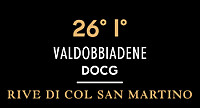
|
|
Valdobbiadene Extra Brut Rive di Col San Martino 26° Primo 2022 |
|
| Andreola (Veneto, Italy) | |
 Glera Glera | |
| Price: € 18.00 | Score: |
 Brilliant greenish yellow and nuances of greenish yellow, very
transparent, fine and persistent perlage. Brilliant greenish yellow and nuances of greenish yellow, very
transparent, fine and persistent perlage.
 Intense, clean, pleasing, refined and elegant, starts with hints of
pear, peach and wisteria followed by aromas of acacia, white rose, broom,
green apple, pineapple, tangerine, medlar and kiwi. Intense, clean, pleasing, refined and elegant, starts with hints of
pear, peach and wisteria followed by aromas of acacia, white rose, broom,
green apple, pineapple, tangerine, medlar and kiwi.
 Effervescent and crisp attack, however balanced by alcohol, light body,
intense flavors, agreeable. Effervescent and crisp attack, however balanced by alcohol, light body,
intense flavors, agreeable.
 Persistent finish with flavors of pear, peach and green apple. Persistent finish with flavors of pear, peach and green apple. Produced with the Charmat method. Produced with the Charmat method. |
|
 Aperitifs, Crustacean and vegetable appetizers, Risotto with vegetable and crustaceans, Vegetable flans, Dairy Products, Eggs Aperitifs, Crustacean and vegetable appetizers, Risotto with vegetable and crustaceans, Vegetable flans, Dairy Products, Eggs |
|
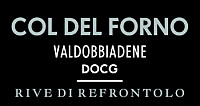
|
|
Valdobbiadene Brut Rive del Refrontolo Col del Forno 2022 |
|
| Andreola (Veneto, Italy) | |
 Glera Glera | |
| Price: € 18.00 | Score: |
 Brilliant greenish yellow and nuances of greenish yellow, very
transparent, fine and persistent perlage. Brilliant greenish yellow and nuances of greenish yellow, very
transparent, fine and persistent perlage.
 Intense, clean, pleasing, refined and elegant, starts with hints of
green apple, pear and wisteria followed by aromas of acacia, white rose,
broom, jasmine, peach, pineapple, tangerine, kiwi, medlar, banana and dill. Intense, clean, pleasing, refined and elegant, starts with hints of
green apple, pear and wisteria followed by aromas of acacia, white rose,
broom, jasmine, peach, pineapple, tangerine, kiwi, medlar, banana and dill.
 Effervescent and crisp attack, however balanced by alcohol, light body,
intense flavors, agreeable. Effervescent and crisp attack, however balanced by alcohol, light body,
intense flavors, agreeable.
 Very persistent finish with long flavors of green apple, pear and
peach. Very persistent finish with long flavors of green apple, pear and
peach.
 Produced with the Charmat method. Produced with the Charmat method. |
|
 Aperitifs, Fish appetizers, Pasta and risotto with fish and crustaceans, Sauteed fish, Dairy products, Eggs Aperitifs, Fish appetizers, Pasta and risotto with fish and crustaceans, Sauteed fish, Dairy products, Eggs |
|
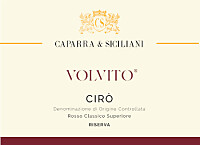
|
|
Cirò Rosso Classico Superiore Riserva Volvito 2020 |
|
| Caparra & Siciliani (Calabria, Italy) | |
 Gaglioppo Gaglioppo | |
| Price: € 11.50 | Score: |
 Intense ruby red and nuances of garnet red, little transparency. Intense ruby red and nuances of garnet red, little transparency. Intense, clean, pleasing, refined and elegant, starts with hints of
plum, black cherry and dried violet followed by aromas of dried rose,
blueberry, raspberry, strawberry, cocoa, tobacco, carob, leather, black
pepper, licorice and vanilla. Intense, clean, pleasing, refined and elegant, starts with hints of
plum, black cherry and dried violet followed by aromas of dried rose,
blueberry, raspberry, strawberry, cocoa, tobacco, carob, leather, black
pepper, licorice and vanilla.
 Properly tannic attack and however balanced by alcohol, good body,
intense flavors, agreeable. Properly tannic attack and however balanced by alcohol, good body,
intense flavors, agreeable.
 Persistent finish with flavors of plum, black cherry and blueberry. Persistent finish with flavors of plum, black cherry and blueberry. 8 months in steel tanks, 8 months in barrique, 6 months in bottle. 8 months in steel tanks, 8 months in barrique, 6 months in bottle. |
|
 Roasted meat, Stewed meat with mushrooms, Broiled meat and barbecue, Cheese Roasted meat, Stewed meat with mushrooms, Broiled meat and barbecue, Cheese |
|
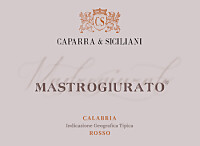
|
|
Mastrogiurato 2020 |
|
| Caparra & Siciliani (Calabria, Italy) | |
 Gaglioppo, Greco Nero Gaglioppo, Greco Nero | |
| Price: € 14.00 | Score: |
 Deep ruby red and nuances of garnet red, little transparency. Deep ruby red and nuances of garnet red, little transparency. Intense, clean, pleasing, refined and elegant, starts with hints of
black cherry, blackberry and plum followed by aromas of dried violet,
carnation, raspberry, blueberry, cocoa, tobacco, leather, cinnamon,
licorice, mace, vanilla and menthol. Intense, clean, pleasing, refined and elegant, starts with hints of
black cherry, blackberry and plum followed by aromas of dried violet,
carnation, raspberry, blueberry, cocoa, tobacco, leather, cinnamon,
licorice, mace, vanilla and menthol.
 Properly tannic attack and however balanced by alcohol, good body,
intense flavors, agreeable. Properly tannic attack and however balanced by alcohol, good body,
intense flavors, agreeable.
 Persistent finish with flavors of black cherry, blackberry and plum. Persistent finish with flavors of black cherry, blackberry and plum. Aged in barrique. Aged in barrique. |
|
 Roasted meat, Stewed meat with mushrooms, Broiled meat and barbecue, Cheese Roasted meat, Stewed meat with mushrooms, Broiled meat and barbecue, Cheese |
|
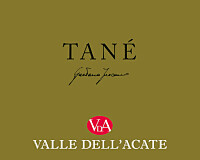
|
|
Vittoria Nero d'Avola Tané 2015 |
|
| Valle dell'Acate (Sicily, Italy) | |
 Nero d'Avola Nero d'Avola | |
| Price: € 32.00 | Score: |
 Intense ruby red and nuances of garnet red, little transparency. Intense ruby red and nuances of garnet red, little transparency. Intense, clean, pleasing, refined and elegant, starts with hints of
plum, black cherry and dried violet followed by aromas of blackberry,
blueberry, carob, cocoa, tobacco, leather, licorice, mace, vanilla and
menthol. Intense, clean, pleasing, refined and elegant, starts with hints of
plum, black cherry and dried violet followed by aromas of blackberry,
blueberry, carob, cocoa, tobacco, leather, licorice, mace, vanilla and
menthol.
 Properly tannic attack and however balanced by alcohol, good body,
intense flavors, agreeable. Properly tannic attack and however balanced by alcohol, good body,
intense flavors, agreeable.
 Persistent finish with flavors of plum, black cherry and blackberry. Persistent finish with flavors of plum, black cherry and blackberry. 12 months in barrique, 14 months in bottle. 12 months in barrique, 14 months in bottle. |
|
 Roasted meat, Stewed and braised meat with mushrooms, Hard cheese Roasted meat, Stewed and braised meat with mushrooms, Hard cheese |
|
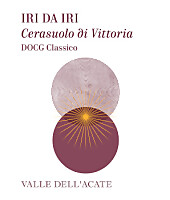
|
|
Cerasuolo di Vittoria Classico Iri da Iri 2015 |
|
| Valle dell'Acate (Sicily, Italy) | |
 Nero d'Avola (60%), Frappato (40%) Nero d'Avola (60%), Frappato (40%) | |
| Price: € 52.00 | Score: |
 Brilliant ruby red and nuances of garnet red, little transparency. Brilliant ruby red and nuances of garnet red, little transparency. Intense, clean, pleasing, refined and elegant, starts with hints of
plum, blackberry and black cherry followed by aromas of dried violet,
blueberry, raspberry, carob, cocoa, tobacco, mace, licorice, cinnamon,
leather, graphite, vanilla and menthol. Intense, clean, pleasing, refined and elegant, starts with hints of
plum, blackberry and black cherry followed by aromas of dried violet,
blueberry, raspberry, carob, cocoa, tobacco, mace, licorice, cinnamon,
leather, graphite, vanilla and menthol.
 Properly tannic attack and however balanced by alcohol, good body,
intense flavors, agreeable. Properly tannic attack and however balanced by alcohol, good body,
intense flavors, agreeable.
 Very persistent finish with long flavors of plum, blackberry and black
cherry. Very persistent finish with long flavors of plum, blackberry and black
cherry.
 24 months in cask, 18 months in bottle. 24 months in cask, 18 months in bottle. |
|
 Broiled meat and barbecue, Roasted meat, Stewed meat with mushrooms, Hard cheese Broiled meat and barbecue, Roasted meat, Stewed meat with mushrooms, Hard cheese |
|
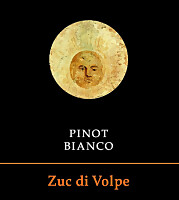
|
|
Friuli Colli Orientali Pinot Bianco Zuc di Volpe 2021 |
|
| Volpe Pasini (Friuli-Venezia Giulia, Italy) | |
 Pinot Bianco Pinot Bianco | |
| Price: € 23.00 | Score: |
 Intense straw yellow and nuances of golden yellow, very transparent. Intense straw yellow and nuances of golden yellow, very transparent. Intense, clean, pleasing, refined and elegant, starts with hints of
apple, pear and peach followed by aromas of hawthorn, white rose, broom,
citron, plum, grapefruit, pineapple, hazelnut and mineral. Intense, clean, pleasing, refined and elegant, starts with hints of
apple, pear and peach followed by aromas of hawthorn, white rose, broom,
citron, plum, grapefruit, pineapple, hazelnut and mineral.
 Crisp attack and however balanced by alcohol, good body, intense
flavors, agreeable. Crisp attack and however balanced by alcohol, good body, intense
flavors, agreeable.
 Persistent finish with flavors of apple, pear and peach. Persistent finish with flavors of apple, pear and peach. Aged in steel tanks. Aged in steel tanks. |
|
 Pasta with fish and crustaceans, Sauteed fish, Sauteed white meat, Fried fish, Dairy products Pasta with fish and crustaceans, Sauteed fish, Sauteed white meat, Fried fish, Dairy products |
|
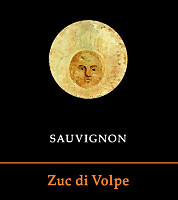
|
|
Friuli Colli Orientali Sauvignon Zuc di Volpe 2022 |
|
| Volpe Pasini (Friuli-Venezia Giulia, Italy) | |
 Sauvignon Blanc Sauvignon Blanc | |
| Price: € 23.00 | Score: |
 Intense straw yellow and nuances of straw yellow, very transparent. Intense straw yellow and nuances of straw yellow, very transparent. Intense, clean, pleasing, refined and elegant, starts with hints of
gooseberry, peach and broom followed by aromas of elder flower, nettle,
citron, pear, apple, pineapple, grapefruit, plum, tomato leaf, bell pepper
and flint. Intense, clean, pleasing, refined and elegant, starts with hints of
gooseberry, peach and broom followed by aromas of elder flower, nettle,
citron, pear, apple, pineapple, grapefruit, plum, tomato leaf, bell pepper
and flint.
 Crisp attack and however balanced by alcohol, good body, intense
flavors, agreeable. Crisp attack and however balanced by alcohol, good body, intense
flavors, agreeable.
 Very persistent finish with long flavors of gooseberry, peach and
citron. Very persistent finish with long flavors of gooseberry, peach and
citron.
 Aged in steel tanks. Aged in steel tanks. |
|
 Crustacean appetizers, Fried fish, Risotto with crustaceans and vegetables, Vegetable flans, Dairy products Crustacean appetizers, Fried fish, Risotto with crustaceans and vegetables, Vegetable flans, Dairy products |
|
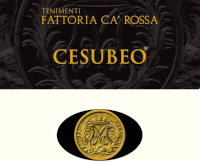
|
|
Cesubeo 2019 |
|
| Fattoria Ca' Rossa (Emilia-Romagna, Italy) | |
 Cabernet Sauvignon, Nebbiolo, Longanesi, Merlot, Petit Verdot, Sirah, Pinot Nero Cabernet Sauvignon, Nebbiolo, Longanesi, Merlot, Petit Verdot, Sirah, Pinot Nero | |
| Price: € 16.00 | Score: |
 Intense ruby red and nuances of ruby red, little transparency. Intense ruby red and nuances of ruby red, little transparency. Intense, clean, pleasing and refined, starts with hints of black
cherry, plum and strawberry followed by aromas of violet, rose, blueberry,
blackberry, raspberry, carob and bell pepper. Intense, clean, pleasing and refined, starts with hints of black
cherry, plum and strawberry followed by aromas of violet, rose, blueberry,
blackberry, raspberry, carob and bell pepper.
 Properly tannic attack and however balanced by alcohol, good body,
intense flavors, agreeable. Properly tannic attack and however balanced by alcohol, good body,
intense flavors, agreeable.
 Persistent finish with flavors of black cherry, plum and blueberry. Persistent finish with flavors of black cherry, plum and blueberry. Aged in steel tanks. Aged in steel tanks. |
|
 Stuffed pasta with meat, Broiled meat and barbecue, Stewed meat with mushrooms, Roasted meat Stuffed pasta with meat, Broiled meat and barbecue, Stewed meat with mushrooms, Roasted meat |
|
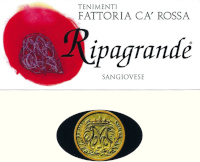
|
|
Ripagrande 2019 |
|
| Fattoria Ca' Rossa (Emilia-Romagna, Italy) | |
 Sangiovese Sangiovese | |
| Price: € 22.00 | Score: |
 Deep ruby red and nuances of garnet red, little transparency. Deep ruby red and nuances of garnet red, little transparency. Intense, clean, pleasing, refined and elegant, starts with hints of
black cherry, plum and violet followed by aromas of rose, strawberry,
raspberry, blueberry, blackberry, tobacco, chocolate, leather, vanilla and
menthol. Intense, clean, pleasing, refined and elegant, starts with hints of
black cherry, plum and violet followed by aromas of rose, strawberry,
raspberry, blueberry, blackberry, tobacco, chocolate, leather, vanilla and
menthol.
 Properly tannic attack and however balanced by alcohol, good body,
intense flavors, agreeable. Properly tannic attack and however balanced by alcohol, good body,
intense flavors, agreeable.
 Persistent finish with flavors of black cherry, plum and strawberry. Persistent finish with flavors of black cherry, plum and strawberry. 36 months in barrique. 36 months in barrique. |
|
 Stuffed pasta with meat, Roasted meat, Broiled meat and barbecue, Stewed meat with mushrooms Stuffed pasta with meat, Roasted meat, Broiled meat and barbecue, Stewed meat with mushrooms |
|
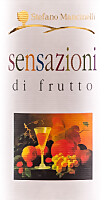
|
|
Lacrima di Morro d'Alba Sensazioni di Frutto 2022 |
|
| Stefano Mancinelli (Marches, Italy) | |
 Lacrima Lacrima | |
| Price: € 10.00 | Score: |
 Deep ruby red and nuances of purple red, little transparency. Deep ruby red and nuances of purple red, little transparency. Intense, clean, pleasing and refined, starts with hints of black
cherry, blackberry and rose followed by aromas of violet, raspberry,
strawberry, plum, pomegranate and blueberry. Intense, clean, pleasing and refined, starts with hints of black
cherry, blackberry and rose followed by aromas of violet, raspberry,
strawberry, plum, pomegranate and blueberry.
 Properly tannic attack and however balanced by alcohol, good body,
intense flavors, pleasing crispness. Properly tannic attack and however balanced by alcohol, good body,
intense flavors, pleasing crispness.
 Persistent finish with flavors of black cherry, blackberry and
raspberry. Persistent finish with flavors of black cherry, blackberry and
raspberry.
 Produced with carbonic maceration. Produced with carbonic maceration. |
|
 Pasta with meat and mushrooms, Sauteed meat with mushrooms Pasta with meat and mushrooms, Sauteed meat with mushrooms |
|

|
|
Terre dei Goti Rosso 2018 |
|
| Stefano Mancinelli (Marches, Italy) | |
 Lacrima Lacrima | |
| Price: € 28.00 | Score: |
 Deep ruby red and nuances of purple red, little transparency. Deep ruby red and nuances of purple red, little transparency. Intense, clean, pleasing, refined and elegant, starts with hints of
black cherry, plum and rose followed by aromas of violet, carnation,
strawberry, raspberry, blueberry, black pepper, cocoa, cinnamon, carob,
leather and vanilla. Intense, clean, pleasing, refined and elegant, starts with hints of
black cherry, plum and rose followed by aromas of violet, carnation,
strawberry, raspberry, blueberry, black pepper, cocoa, cinnamon, carob,
leather and vanilla.
 Properly tannic attack and however balanced by alcohol, good body,
intense flavors, agreeable. Properly tannic attack and however balanced by alcohol, good body,
intense flavors, agreeable.
 Very persistent finish with long flavors of black cherry, plum and
strawberry. Very persistent finish with long flavors of black cherry, plum and
strawberry.
 Produced with dried grapes. 2 years in barrique, 2 years in cask, 3
months in bottle. Produced with dried grapes. 2 years in barrique, 2 years in cask, 3
months in bottle.
|
|
 Stuffed pasta with meat and mushrooms, Roasted meat, Stewed meat with mushrooms Stuffed pasta with meat and mushrooms, Roasted meat, Stewed meat with mushrooms |
|
News |
|
In this section are published news and information about events concerning the world of wine and food. Whoever is interested in publishing this kind of information can send us a mail to our address.
|
AquavitaeReview of Grappa, Distillates and Brand |
|
|
||||||||||||||||||||||||||
Wine Guide ParadeJanuary 2024
|
| |||||||
Privacy Policy | |||||||


| Copyright © 2002-2024 Antonello Biancalana, DiWineTaste - All rights reserved |
| All rights reserved under international copyright conventions. No part of this publication and of this WEB site may be
reproduced or utilized in any form or by any means, electronic or mechanical, without permission in writing from DiWineTaste. |